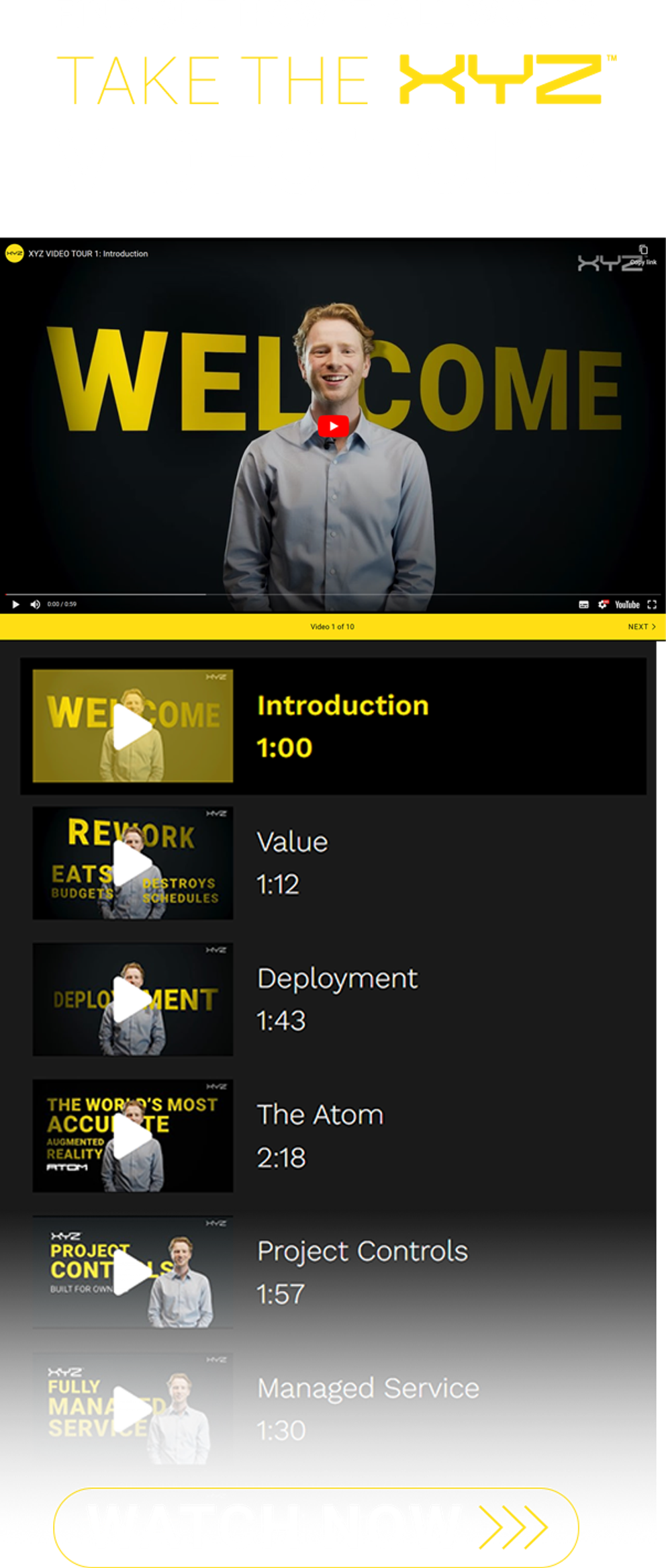-
Services
Services
Find out how we work with our clients and deliver value to construction projects from day one
-
Solutions
Solutions
Discover how all our solutions sync together to deliver construction's most powerful BIM platform to date
-
Built for
Built for
-
Industry
Industry
Understand how we support construction's biggest sectors, and hear from our clients who have experienced the power of XYZ
-
Resources
Resources
Get stuck into all our latest thought leadership, news, reports and industry leading content
-
Company
Company
Dive into what makes XYZ tick, unearth why construction is in our DNA and why we are world leaders in AR solutions

Insights
Safety First: Must-Remember Tips for Construction Safety Week

06 May 2024
It is no secret that construction is a dangerous profession that involves physically demanding tasks and equipment. Improper handling of tools and machinery can cause severe injuries, and working at height poses a significant risk of falls.
Health and Safety Executive statistics from 2022/23 showed that falls from heights resulted in 33% of non-fatal work-related injuries, followed by slips and trips at 30% and those struck by a moving object at 14%. Despite safety procedures, construction sites can still be hazardous.
Construction Safety Week is a crucial time for contractors and construction companies to assess their safety procedures and explore new ways to ensure site safety. Here, we explore methods for improving safety on construction sites and enhancing the effectiveness of current safety methods.
Safety-certified Equipment
Construction workers who are not properly equipped with the right gear are at risk of making fatal errors. Every piece of equipment must be ideally suited for the task at hand. Additionally, construction firms must ensure that all machinery and materials are well maintained to prevent any accidents.
Providing workers with appropriate personal protective equipment (PPE) is one of the most important steps employers should take to keep crews safe on the job. This equipment needs to be regularly checked too, for instance, hard hats must be tested for their integrity and replaced if necessary. This is especially true for long-term projects likely to continue for years to come.
For instance, our engineering grade augmented reality™ (AR) headset, the Atom™ has been built with safety in mind and serves as an example of rigorously tested equipment, having been safety verified by both BSI and ANSI.
Ultimately, well maintained construction equipment is essential for ensuring safety at a construction site and reducing the risk of accidents due to oversight.
Provide onsite and offsite safety training
Ensuring that everyone on the job site is adequately trained, certified, and qualified is paramount for safety and competence. A comprehensive training program should cover not only specific trades, tools, and equipment but also broader health and safety protocols.
Training sessions on construction sites typically address critical topics like fall protection and proper ladder usage, intending to equip every worker with the knowledge to handle safety procedures effectively in case of emergencies. While regular safety training sessions are essential throughout the year, providing opportunities for on-the-job practice can significantly enhance workers' ability to enforce safety regulations.
Practicing safety skills directly in the construction environment is invaluable, as it reinforces learning in a context where safety is paramount. This hands-on approach ensures that workers are not only trained but also proficient in implementing safety measures effectively.
Some organizations employ visual aids to underscore the various risks and potential injuries inherent in construction work. Employing a diverse array of training techniques, rather than relying solely on manuals, can enhance engagement and understanding among employees, thereby promoting a safer work environment overall.
Virtual Reality (VR) is revolutionizing training and skills enhancement across the construction industry. Through the utilization of VR tech, businesses can craft lifelike simulations of construction settings, plunging trainees into immersive 3D realms that replicate the intricacies and hurdles encountered on real construction sites.
Keeping communication lines open
Accidents are more likely to occur when workers are uncertain about what lies ahead. Openly discussing daily goals and activities reduces surprises that could lead to injuries. Without clear communication among all construction site personnel, workers can face unexpected situations.
Effective communication accelerates project progress and ensures everyone stays informed. Keeping workers informed and ensuring each person understands their role is essential for maintaining construction site safety.
Before construction work begins, it’s important to have a comprehensive plan in place. This includes:
- Having all necessary permits and certifications
- Developing a clear chain of command for reporting incidents
- Creating an emergency response plan for potential hazards
- Establishing safety protocols and procedures
- Conducting safety training sessions for workers and contractors
- Identifying any potential risks or hazards.
It’s also important to make sure that all employees are aware of their rights under local regulations.
Implementation of modern technology has allowed for swift communication between onsite workers (software such as teams, outlook, etc.) allowing workers to bring up issues in a variety of ways and be able to address the whole workforce when they can.
Ensuring Documentation of Sites and Incidents
To ensure the safety of a construction site, workers must make sure they have proper documentation of everything that is going to be done onsite that day.
Supervisors and contractors who will be charged with particularly difficult tasks should provide evidence of their certification well in advance of their employment on the job site, which not only prevents accidents due to improper training but protects the construction firm from legal action and public scrutiny. A recent case in New York revealed that a construction safety firm and 25 people were charged for falsely certifying thousands of workers' safety training. Tragically, one worker the firm claimed to have trained died on the job.
Modern construction software platforms include tools to record and report on safety incidents, which enables workers to track any incidents during the project. Regular construction safety reports help managers identify the root cause of common hazards and future impacts. Daily site inspections are crucial for tracking project progress, identifying changes, and assessing potential risks. They provide clarity on project status and enhance productivity while ensuring worker safety.
Modern technology empowers supervisors to conduct rapid inspections and address project changes swiftly. Augmented Reality integration enables real-time updates, enhancing efficiency. Atom™ demonstrates the effectiveness of addressing issues pre-emptively, notifying all project personnel promptly to mitigate injury risks.
Site Supervision
To maintain a secure work environment on the job site, a proficient and committed supervisor is indispensable. Their role extends beyond mere enforcement of safety standards; they must vigilantly oversee all personnel, swiftly correcting any deviations from established safety protocols.
Vigilance is key, as supervisors must promptly address potential hazards like exposed wiring or slippery surfaces to safeguard workers from harm. They should possess a comprehensive understanding of pertinent regulations such as those outlined by HSE or Occupational Safety and Health Administration (OSHA), ensuring strict compliance among all onsite personnel.
Additionally, supervisors must be adept at identifying unsafe practices or shortcuts taken by workers and intervening decisively to avert any potential incidents.
Moreover, proactive planning is essential to anticipate unforeseen challenges that could prolong tasks. By doing so, supervisors facilitate efficient project completion, mitigating the need for overtime and associated costs while upholding safety standards.
Transparency with workers
We recognize that accidents can occur despite contractors’ best efforts to promote a safe environment for their employees. In such instances, these accidents serve to underscore the growing importance to augment modern safety techniques.
Transparent communication fosters an environment where everyone feels comfortable speaking up and raising concerns. This allows Enviromental, Health and Safety (EHS) teams to work together to identify potential issues before they become larger problems.
Creating a culture of safety is crucial for every workplace. When employees feel empowered to speak up about any concerns they have or if they have suggestions for improvements, it helps to prevent accidents and mishaps. Being on the same page about what needs to be done and why it needs to be done is essential in increasing efficiency and reducing the likelihood of mistakes due to miscommunication.
Implementation of Advanced Technological Solutions
In recent years, modern technology has played a crucial role in construction, with the industry witnessing significant investment, reaching approximately $5.38 billion in 2022. This growth has led to the emergence of various technologies, including drones, Artificial Intelligence (AI), Virtual Reality (VR) for safety training, and Augmented Reality (AR) for pre-emptive issue identification, all contributing to enhanced site safety.
The Atom headset boasts proactive validation features that streamline workflows, accelerating construction processes. This reduction in rework is crucial, given that 39% of all construction injuries occur during such phases. By minimizing the need for onsite personnel, it mitigates the risk of injuries during rework. This alleviation of time constraints prevents rushed work and potential errors, ensuring both performance and safety are maintained at optimal levels.
Construction sites are often unpredictable, and circumstances can shift in the blink of an eye. As projects grow more complex and larger in scale, improving safety on these sites, requires a multi-faceted approach. This involves proper training, implementation of protocols and equipment, encouraging open communication on site, and utilizing cutting-edge technology. By doing so, safety can be established as a core value and the risk of accidents and injuries can be greatly reduced.
Discover how cutting-edge technology can safeguard your next project. Ensure accuracy, efficiency, and safety throughout your construction endeavors. Schedule your demo now at www.xyzreality.com/demo.








